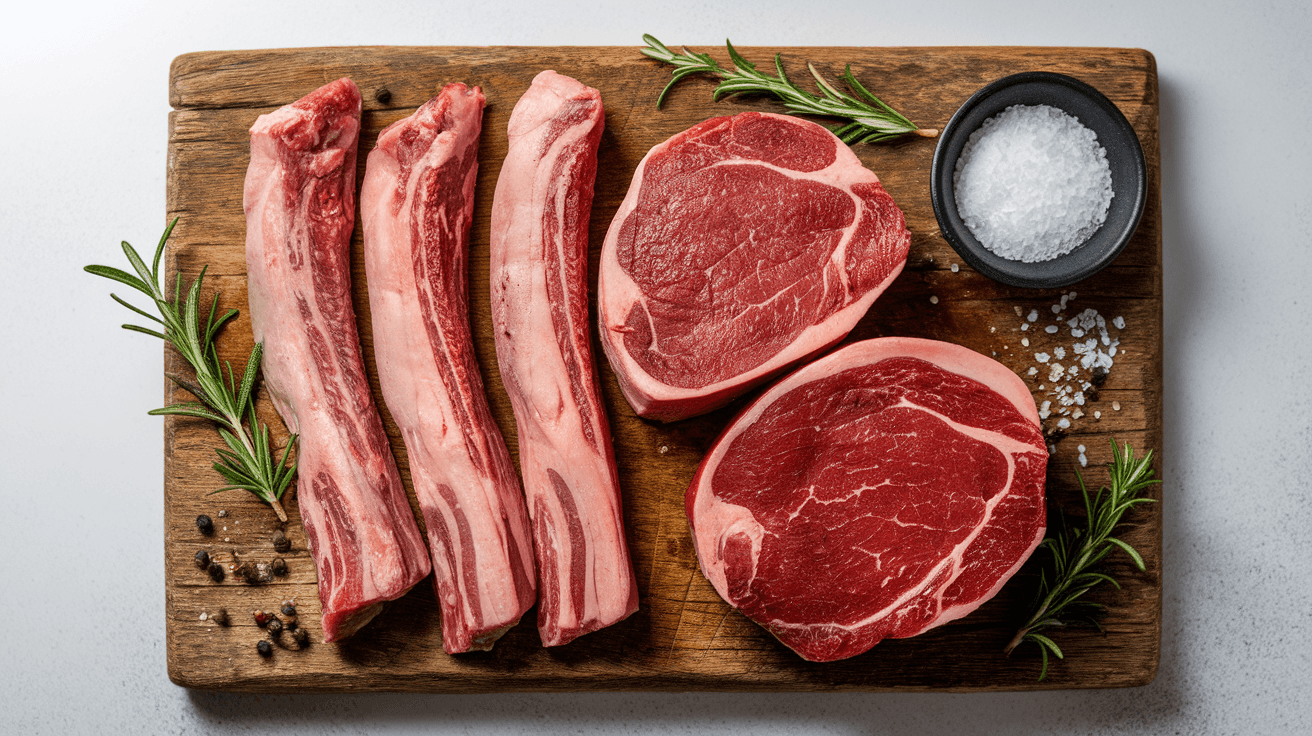Introduction
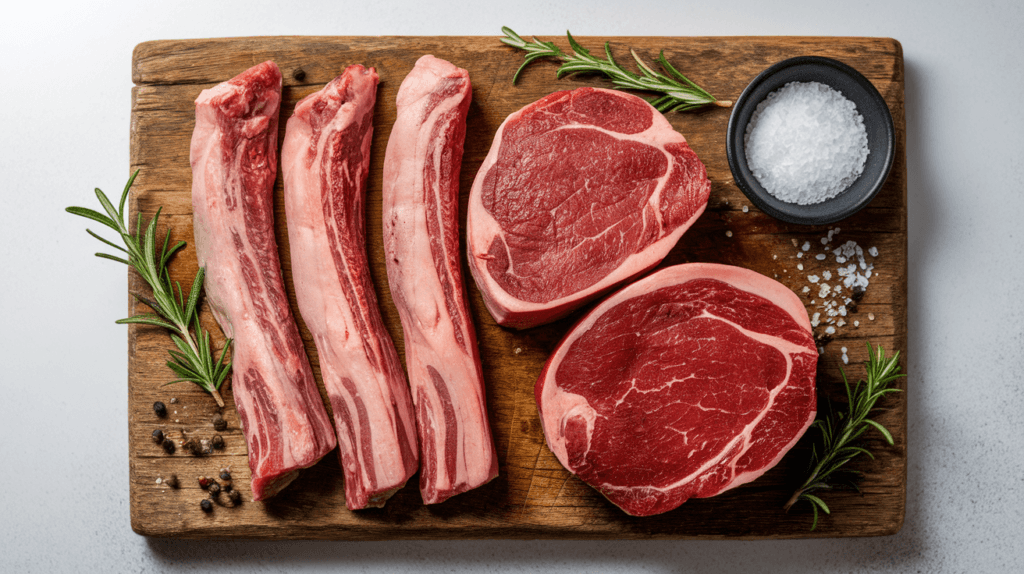
Beef fans often see different cuts of meat and wonder how they differ. One such common query is whether tenderloin tips are the same as filet mignon. People prize both cuts for their tenderness and often associate them with fine dining and exceptional flavor. Nevertheless, despite originating from the same part of the cow—the tenderloin—they differ significantly in terms of size, preparation, and use.
In this article, we’ll delve deep into the similarities and differences between tenderloin tips and filet mignon, explore their culinary applications, and offer insights to help you decide which is best for your next meal.
Understanding Tenderloin Tips: Are They Similar to Filet Mignon?
Tenderloin tips, in contrast, are small, irregular cuts of meat sourced from the ends of the beef tenderloin. While not as uniform in shape as filet mignon, people still prize them for their tenderness and rich flavor.
What Are Tenderloin Tips? Are They Comparable to Filet Mignon?
Tenderloin tips are the remnants or trimmings from the larger tenderloin muscle. These pieces typically have irregular shapes and may vary in size. Their smaller size and uneven structure make them less suited for presentation as a steak. Instead, they are ideal for other types of dishes.
Origin and Preparation of Tenderloin Tips
The tenderloin is a long, narrow muscle located along the spine of the cow. Tenderloin tips come from the tapered end or the sections trimmed during the cutting of filet mignon or other steaks. As a result, butchers often sell them in pre-packaged portions, making them more affordable than whole tenderloin steaks.
Because of this, tenderloin tips are excellent for recipes that require quick cooking, such as:
- Stir-fries
- Beef skewers
- Soups and stews
- Pasta dishes
Tenderloin tips soak up marinades well, making them great for many dishes and flavors.
What Is Filet Mignon and How Does It Differ from Tenderloin Tips?
Indeed, filet mignon is one of the most coveted cuts of beef, celebrated for its unparalleled tenderness and mild flavor. This cut is synonymous with elegance and is a staple in fine dining establishments worldwide.
Characteristics of Filet Mignon
Filet mignon, French for “dainty filet,” is a small, cylindrical cut of beef taken from the tenderloin muscle. People know it for:
- Tenderness: Since the tenderloin muscle does very little work, people consider filet mignon the most tender cut of beef.
- Size and Shape: Filet mignon steaks are typically 1–2 inches thick and uniform in shape, making them visually appealing.
- Mild Flavor: The cut has a subtle beefy flavor, which pairs well with sauces, rubs, and seasonings.
Where Does Filet Mignon Come From?
Moreover, filet mignon comes from the center portion of the tenderloin muscle, which runs along the spine of the cow. This muscle is located in the loin primal section and is part of the psoas major.
Consumers highly seek filet mignon and pay more for it because butchers can use only a small portion of the tenderloin for this specific cut compared to others.
Preparation and Uses of Filet Mignon
Chefs often sear filet mignon and finish it in the oven to ensure even cooking and lock in its natural juices. Chefs commonly cook it using the following methods:
- Pan-Seared and Oven-Roasted: A classic technique to achieve a perfect crust and tender interior.
- Grilled: Adds a smoky flavor while maintaining the cut’s natural tenderness.
- Sous Vide: Ensures precision cooking, delivering a uniformly tender result.
Restaurants typically serve filet mignon as a standalone steak, but it also features in recipes like Beef Wellington or paired with rich sauces such as Béarnaise or red wine reduction.
Key Similarities Between Tenderloin Tips and Filet Mignon
Tenderloin tips and filet mignon share several similarities since both originate from the tenderloin.
Similarities in Tenderness and Texture
Similarly, both cuts are exceptionally tender because they come from the tenderloin muscle, which bears little weight and remains largely unused during the cow’s life. This lack of stress on the muscle fibers results in meat that practically melts in your mouth.
Both Are From the Tenderloin
Since tenderloin tips are simply smaller, irregular sections of the tenderloin, they share the same foundational qualities as filet mignon. This includes the soft texture and ability to take on complementary flavors like herbs, butter, and marinades.
Major Differences: Tenderloin Tips vs. Filet Mignon
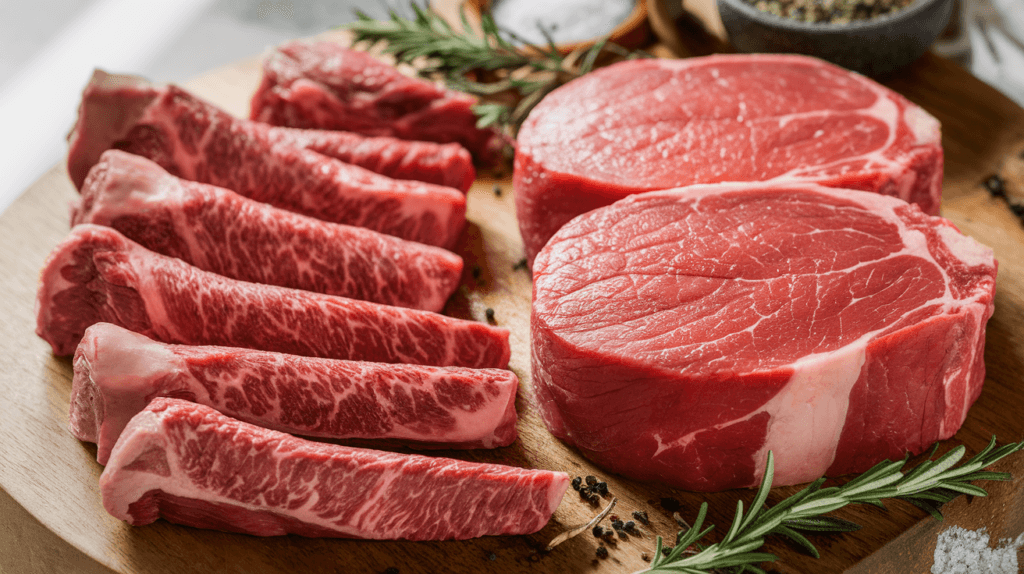
Although tenderloin tips and filet mignon come from the same part of the cow, they differ in size, shape, flavor, and how they are used in cooking. These distinctions are key to understanding which cut is best suited for specific culinary applications.
Size and Cut Style
- Tenderloin Tips: These are smaller, irregular pieces of meat, often cut from the ends of the tenderloin or trimmed from larger steaks. They lack the uniformity of filet mignon, which makes them ideal for dishes where presentation isn’t the focus.
- Filet Mignon: This is a whole steak, typically cut into thick, uniform medallions from the tenderloin’s center. It is prized for its appearance as well as its tenderness.
Cooking Techniques: How Tenderloin Tips and Filet Mignon Differ
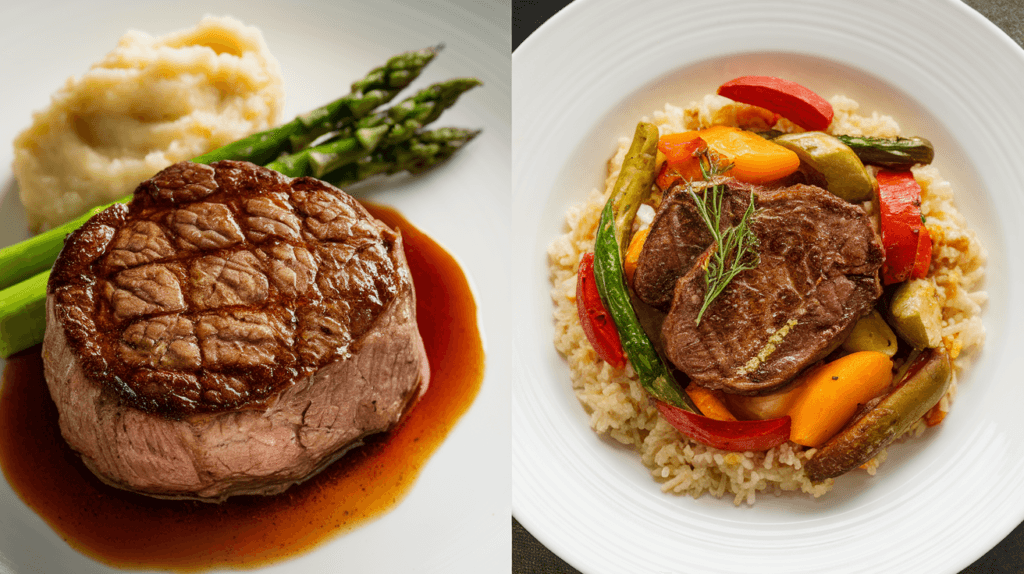
The irregular shape of tenderloin tips allows them to cook quickly and evenly in high-heat methods like stir-frying or sautéing. Filet mignon, on the other hand, is usually prepared using methods that enhance its visual appeal and tenderness, such as grilling, roasting, or sous vide.
Flavor Profiles
- Tenderloin Tips: Because of their smaller size and often being part of a well-marbled tenderloin, these tips can sometimes offer a slightly richer beef flavor compared to the mild taste of filet mignon. They also absorb marinades and sauces well, making them highly versatile.
- Filet Mignon: Known for its delicate, subtle flavor, filet mignon often relies on external additions like compound butter, wine-based sauces, or robust seasonings to enhance its taste.
Cost Differences
Filet mignon is significantly more expensive than tenderloin tips due to its desirability, uniformity, and limited availability on the tenderloin. In contrast, tenderloin tips are more economical, offering similar tenderness at a fraction of the price.
Tenderloin Tips: Best Uses and Comparison with Filet Mignon
Home cooks celebrate tenderloin tips for their versatility and ability to adapt to various recipes. Their affordability and smaller size make them a go-to choice for home cooks looking to enjoy tender beef without the premium cost.
Culinary Applications
- Stir-Fries: The small, tender pieces of meat are ideal for quick-cooking dishes where they can absorb flavorful sauces and spices.
- Stews and Soups: Tenderloin tips remain tender even after slow cooking, making them a great choice for hearty stews or broth-based soups.
- Skewers: Perfect for grilling, tenderloin tips can be threaded onto skewers with vegetables for an easy barbecue option.
- Pasta Dishes: Tossed with pasta, a creamy sauce, and vegetables, tenderloin tips elevate everyday meals into gourmet experiences.
Popular Recipes Featuring Tenderloin Tips
- Garlic Butter Tenderloin Tips: Sauté tenderloin tips in garlic butter for a quick, flavorful meal.
- Teriyaki Beef Stir-Fry: Combine tenderloin tips with a mix of fresh vegetables and a sweet soy-based sauce.
- Beef Tips in Red Wine Sauce: Slow-cooked in a savory red wine reduction, this dish pairs well with mashed potatoes or crusty bread.
Filet Mignon: Culinary Uses and Why It’s Different from Tenderloin Tips
Filet mignon is the pinnacle of luxury in beef cuts, known for its melt-in-your-mouth tenderness and refined presentation. Its culinary applications are typically geared toward showcasing its quality in dishes that highlight simplicity and elegance.
Culinary Applications
- Fine Dining Entrées: Filet mignon is often the star of upscale menus, paired with sides like roasted vegetables, mashed potatoes, or risotto.
- Beef Wellington: This classic dish wraps filet mignon in layers of mushroom duxelles, prosciutto, and puff pastry for a show-stopping main course.
- Steak and Seafood Combinations: Filet mignon is frequently paired with lobster, shrimp, or scallops in surf-and-turf meals.
- Steak Tartare: The buttery texture of filet mignon makes it a popular choice for this raw preparation, where the beef is finely chopped and seasoned with spices, egg yolk, and capers.
Popular Recipes Featuring Filet Mignon
- Classic Pan-Seared Filet Mignon: Sear the steak in a hot skillet with butter, garlic, and rosemary, then finish it in the oven for a perfectly cooked interior.
- Grilled Filet Mignon with Herb Butter: This recipe lets the natural flavor of the beef shine, complemented by a dollop of homemade herb butter.
- Filet Mignon with Red Wine Sauce: A rich reduction made with red wine, shallots, and beef stock enhances the delicate flavor of the filet.
- Filet Mignon Wrapped in Bacon: The smoky, salty flavor of bacon pairs beautifully with the mild, tender filet.
Why Choose Filet Mignon?
Filet mignon’s even size and soft texture make it perfect for special meals and fancy dining. Its versatility allows it to adapt to a range of flavor profiles, from simple seasonings to complex sauces.
Cooking Techniques
While tenderloin tips and filet mignon both benefit from careful cooking, their preparation methods differ due to their unique sizes and uses.
How to Cook Tenderloin Tips
Tenderloin tips are best suited for quick cooking methods that highlight their tenderness without overcooking. Popular techniques include:
- Sautéing: Heat a skillet with oil or butter and cook the tips over medium-high heat for 3–5 minutes, depending on the desired doneness.
- Stir-Frying: Cook the tips with vegetables and a sauce in a wok or large skillet, ensuring everything is evenly coated and heated through.
- Grilling: Thread the tips onto skewers and grill over medium-high heat for 6–8 minutes, turning frequently.
- Slow Cooking: For stews or braised dishes, tenderloin tips can be simmered over low heat to absorb rich flavors while maintaining their tenderness.
Best Methods for Cooking Filet Mignon
Filet mignon requires precision to preserve its delicate texture and avoid drying out. Common cooking methods include:
- Pan-Searing and Oven-Finishing: Sear the steak in a hot skillet for a caramelized crust, then transfer it to the oven to cook through evenly.
- Grilling: Cook over medium-high heat, flipping once, to achieve a smoky, charred exterior.
- Sous Vide: Seal the filet in a vacuum bag and cook it at a precise temperature in a water bath, ensuring perfect doneness every time.
Cooking Tips for Both Cuts
- Use a meat thermometer to avoid overcooking. Aim for 130–135°F for medium-rare filet mignon and tenderloin tips.
- Let the meat rest for 5–10 minutes after cooking to allow the juices to redistribute.
- Season generously with salt and pepper, and consider finishing with a pat of butter or a drizzle of olive oil for added richness.
Nutritional Comparison
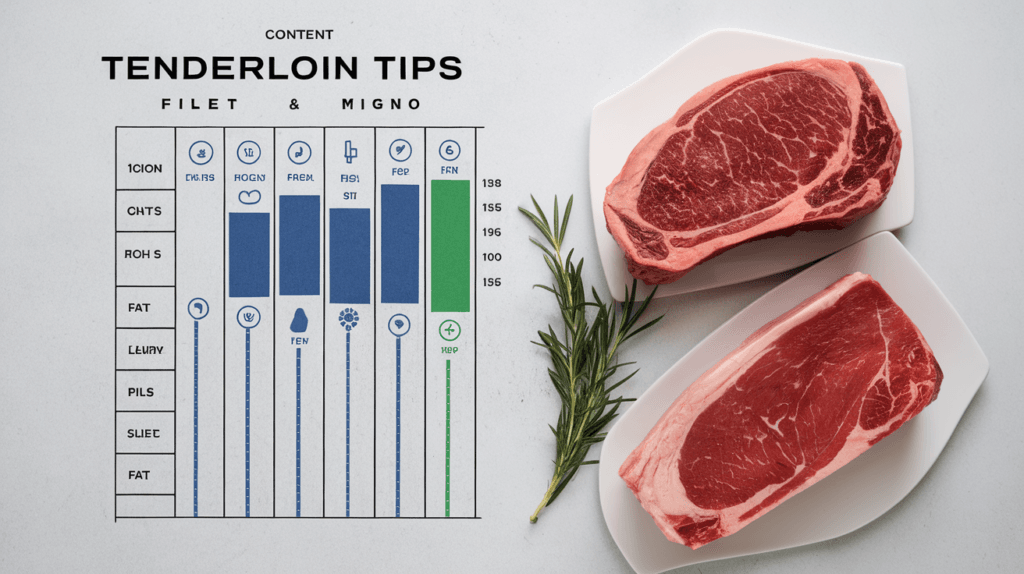
When comparing tenderloin tips and filet mignon, their nutritional profiles reveal subtle differences that may influence your choice, depending on dietary needs or preferences.
Protein Content
These cuts provide high-quality protein, which is essential for muscle repair and overall health.
- Tenderloin Tips: Contain slightly more protein per ounce due to their smaller size and more compact muscle fibers.
- Filet Mignon: Offers a comparable amount of protein but in a thicker, steak-like form, making it more satisfying for larger portions.
Fat and Caloric Differences
- Tenderloin Tips: Generally have a slightly higher fat content because they include trimmings from various parts of the tenderloin, which may contain marbling or external fat. A 3-ounce serving averages around 200 calories.
- Filet Mignon: Known for its lean composition, a typical 3-ounce filet contains around 170 calories, with minimal fat compared to other steak cuts.
Micronutrient Content
Both cuts provide essential vitamins and minerals, such as:
- Iron: Supports oxygen transport in the blood.
- Zinc: Boosts immune function and aids in wound healing.
- B Vitamins: Essential for energy metabolism and maintaining healthy nerves.
Both cuts are healthy choices for a balanced diet because their differences are small
Flavor Profiles
Despite their shared origin, the flavor profiles of tenderloin tips and filet mignon vary due to their size, fat content, and cooking applications.
Tenderloin Tips
- Flavor Intensity: Slightly richer and more pronounced beef flavor, especially when marinated or cooked with bold seasonings.
- Adaptability: Absorbs sauces, marinades, and seasonings exceptionally well due to its irregular shape and larger surface area.
- Texture: While tender, tenderloin tips may have slight variations in texture, offering a mix of juicy bites and denser pieces depending on the cut.
Filet Mignon
- Flavor Intensity: Subtle and mild, allowing the natural beef flavor to shine without overpowering.
- Delicacy: Its uniform texture and lean profile give it a “melt-in-your-mouth” quality, making it a favorite for minimal seasoning and gourmet sauces.
- Pairing Potential: Complements buttery, creamy, or tangy accompaniments like Béarnaise sauce, truffle butter, or blue cheese.
Cost Considerations
Why Filet Mignon Is Pricier
Filet mignon’s high cost can be attributed to several factors:
- Limited Availability: Only a small portion of the tenderloin can be cut into filet mignon steaks, making it a scarce commodity.
- Demand: Its reputation for tenderness and association with fine dining drives up consumer demand.
- Labor-Intensive Processing: Filet mignon requires precision cutting and trimming to achieve its characteristic shape and size.
Tenderloin Tips: A Budget-Friendly Alternative
Tenderloin tips are significantly more affordable, offering similar tenderness and flavor at a fraction of the price. They are ideal for families or those looking to enjoy high-quality beef without the premium cost of filet mignon.
Expert Opinions
To gain a deeper understanding of the differences between tenderloin tips and filet mignon, insights from chefs and butchers can provide clarity.
What Chefs Say
Professional chefs value both cuts for their versatility but use them for different purposes:
- Tenderloin Tips: Renowned for their adaptability, tenderloin tips are often used in recipes that prioritize flavor absorption, such as stir-fries and stews. Chef Sarah Hammond notes, “Tenderloin tips are a home cook’s best friend—they’re tender, quick to cook, and work well with bold seasonings.”
- Filet Mignon: Chefs reserve filet mignon for dishes that emphasize presentation and simplicity. “Filet mignon is all about elegance and texture. You don’t want to overpower it; let the natural tenderness speak for itself,” says Chef Martin Reyes, a steakhouse expert.
Butcher Insights
Butchers highlight the differences in preparation and cost:
- Tenderloin tips are by-products of trimming the tenderloin, making them an economical option. According to butcher Greg Olson, “When you’re trimming a tenderloin for steaks, the tips are what’s left. They’re great for people who want tender meat without the hefty price tag.”
- Filet mignon, on the other hand, requires careful portioning from the tenderloin’s center, making it a premium product.
FAQs
1. Are tenderloin tips as tender as filet mignon?
Yes, tenderloin tips are almost as tender as filet mignon since they come from the same muscle. However, their irregular shape may result in slight variations in texture.
2. Can you substitute one for the other?
In some recipes, tenderloin tips can be substituted for filet mignon, especially in dishes like stir-fries or stews. However, for recipes that rely on presentation, such as a plated steak dinner, filet mignon is the better choice.
3. Which is better for grilling?
Both cuts can be grilled, but filet mignon’s uniform shape makes it easier to cook evenly. Tenderloin tips are better suited for skewers or quick-grill recipes.
4. How can I identify tenderloin tips at the store?
Look for small, irregularly shaped pieces of beef labeled as tenderloin tips. They are often packaged in portions and may be marketed as “beef tips.”
5. Is filet mignon healthier than tenderloin tips?
Filet mignon is slightly leaner and contains fewer calories than tenderloin tips, but the difference is minimal. Both are excellent choices for a high-protein, low-fat meal.
6. What sauces pair well with each cut?
- Tenderloin Tips: Bold sauces like teriyaki, chimichurri, or red wine reduction.
- Filet Mignon: Delicate sauces such as Béarnaise, mushroom cream, or peppercorn sauce.
Conclusion
While tenderloin tips and filet mignon both come from the tenderloin, their differences in size, shape, flavor, and price make them suitable for distinct culinary purposes.
- Choose tenderloin tips for versatile, budget-friendly meals like stir-fries, stews, or skewers.
- Opt for filet mignon when you want to impress with a luxurious, melt-in-your-mouth steak, perfect for special occasions.
Understanding these distinctions allows you to make an informed choice, ensuring the perfect cut for your next dish. Both options offer tenderness and flavor, catering to various tastes and budgets, making either a fantastic addition to your menu.

